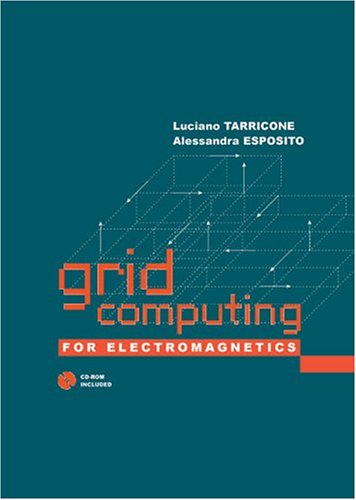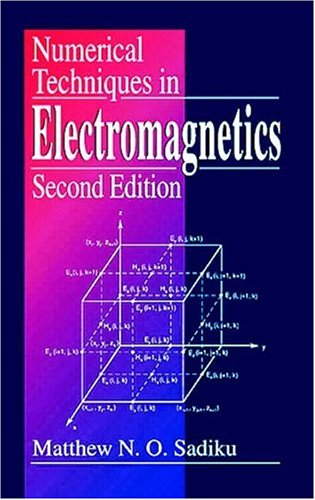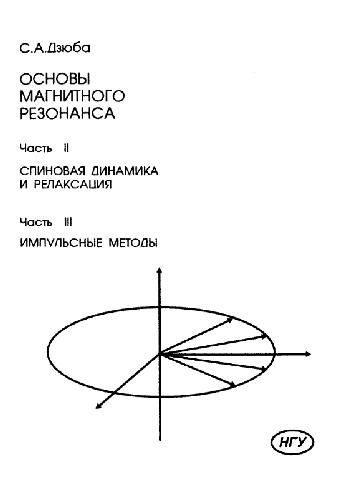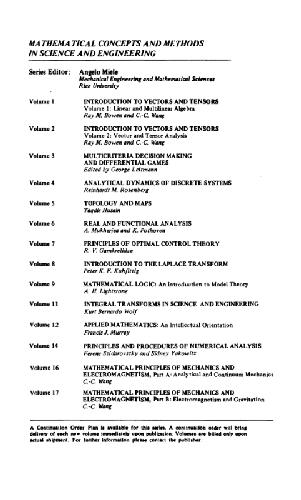Luciano Tarricone, Alessandra Esposito1580537774, 9781580537773, 9781580537780
Table of contents :
Team DDU……Page 1
Contents……Page 6
Acknowledgments……Page 12
Grid Computing: What Is It?……Page 14
Grid Computing: An Opportunity for Electromagnetics Research……Page 16
How to Read This Book……Page 18
References……Page 19
1.1 Introduction……Page 20
1.2 Parallel and Distributed Architectures……Page 21
1.3 Parallel and Distributed Topologies……Page 24
1.4 Parallel and Distributed Programming……Page 26
1.4.1 Message Passing……Page 27
1.4.2 Shared-Memory Programming……Page 28
1.5 Performance Assessment……Page 29
1.6 Web Computing……Page 30
1.7.1 Introduction……Page 33
1.7.2 What Is a Grid?……Page 34
1.7.3 Grid Architecture……Page 36
1.7.4 Grid Middleware……Page 38
1.7.5 Applications……Page 39
References……Page 40
2.1 Introduction……Page 42
2.2.1 Object Orientation for Software Engineering……Page 43
2.2.2 Object Orientation for Enabling Technologies……Page 44
2.2.3 CORBA……Page 45
2.2.4 Java……Page 46
2.2.5 Object Orientation and Electromagnetic Simulators……Page 47
2.2.6 Conclusions……Page 48
2.4 The Globus Toolkit: An Overview……Page 49
2.5 The Globus Toolkit: The Globus Security Infrastructure……Page 50
2.5.1 Authorization……Page 51
2.5.2 Mutual Authentication……Page 52
2.5.3 Single Sign On and Delegation……Page 54
2.5.4 Other Services……Page 56
2.6 The Globus Toolkit: The Resource Management Pillar……Page 57
2.7 The Globus Toolkit: The Information Services Pillar……Page 61
2.7.2 MDS Information Model……Page 62
2.8.1 Distributed Data Access and Management……Page 65
2.8.2 Dataset Replicas Services……Page 66
2.9 The Globus Tools API……Page 67
2.10 The MPI with Globus……Page 68
2.12 Web-Based Technologies and Projects……Page 70
References……Page 72
3.1 Introduction……Page 76
3.2 Recalling Globus Basic Concepts……Page 77
3.3.3 Setting Up the Network……Page 79
3.3.4 Before Installing Globus……Page 80
3.4.1 Downloading the Package……Page 81
3.4.2 Installing the Toolkit……Page 82
3.5 Globus Configuration……Page 83
3.5.1 Authorization……Page 84
3.5.3 Using the Globus CA……Page 85
3.5.4 Using a Local CA……Page 87
3.6.2 Information Services……Page 91
3.6.3 Data Management……Page 92
3.8 Globus-Relevant Commands to Use the Grid……Page 93
3.8.2 Resource Management……Page 94
3.8.3 Information Services……Page 97
3.8.4 Data Management……Page 99
3.9 Developing Grid-Enabled Applications……Page 101
3.9.1 An Example with Globus API……Page 102
3.10 Message Passing in a Grid Framework……Page 104
References……Page 106
4.2.1 Yee’s Algorithm……Page 108
4.2.3 Numerical Dispersion……Page 111
4.2.4 Excitation and Absorbing Boundary Conditions……Page 112
4.2.5 CPU Time and Memory Requirements……Page 114
4.3.1 A Simple and Portable Parallel Algorithm……Page 115
4.4.1 Introduction……Page 127
4.4.2 Practical Guidelines……Page 128
4.4.3 Pthread Libraries and MPICH-G2……Page 129
4.5.1 Performance Evaluation of Parallel Distributed FDTD……Page 130
4.5.2 MPICH-G2 Performance Evaluation……Page 131
4.5.3 Benchmarking Parallel FDTD on a Grid……Page 134
4.6 Remarkable Achievements……Page 135
References……Page 136
5.1 Introduction……Page 140
5.2.1 Theoretical Background……Page 142
5.2.2 Approaches Based on Waveguide Modes……Page 144
5.2.3 Approaches Based on Gegenbauer’s Polynomials……Page 146
5.3 A Tool for the CAE of Rectangular Aperture Antenna Arrays……Page 147
5.3.1 Evaluation of the Horns’ Scattering Matrix……Page 148
5.3.2 Evaluation of the Aperture Array’s Scattering Matrix……Page 149
5.3.3 Evaluation of the Scattering Matrix at External Ports……Page 151
5.3.4 Evaluation of the Radiation Pattern……Page 153
5.4 Parallel CAE of Aperture Arrays……Page 154
5.4.1 Preliminary Analysis……Page 155
5.4.2 Parallelization……Page 158
5.4.3 Results on MIMD Supercomputing Platforms……Page 161
5.5 Migration Toward Grid Environments……Page 163
5.5.1 Supporting Cooperative Engineering with GC……Page 164
5.6 Conclusions……Page 169
References……Page 170
6.1 Introduction……Page 172
6.2.1 General Considerations……Page 173
6.2.2 Frequency Reuse……Page 174
6.2.3 Capacity and Traffic……Page 176
6.2.5 BS Antennas……Page 177
6.3.1 Power Control……Page 179
6.3.3 System Standardization and Interoperability……Page 180
6.4 Planning Wireless Networks……Page 181
6.5 An Integrated System for Optimum Wireless Network Planning……Page 182
6.5.1 Overview of the System……Page 183
6.6 A Candidate Architecture for an Effective ISNOP……Page 188
6.8 Wireless Network Planning with GC……Page 189
6.8.1 Data Communication with GC in a Simplified ISNOP……Page 192
6.8.2 ENC Module Simulation……Page 197
6.9 Conclusions……Page 199
References……Page 200
7.1 GC: Benefits and Limitations……Page 202
7.2 GC Trends……Page 203
References……Page 204
A.1 UNIX/Linux Operating System: An Overview……Page 206
A.3.1 Introduction……Page 207
A.3.2 File System Relevant Commands……Page 208
A.3.3 Pathnames……Page 210
A.3.5 Permissions……Page 211
A.4 Processes……Page 212
A.6.1 Introduction……Page 213
A.6.3 Redirection……Page 215
A.6.5 Environment Variables……Page 216
References……Page 217
B.1 Introduction……Page 218
B.2 Confidentiality and Cryptography……Page 219
B.3 Digital Signature……Page 221
B.4 Certificates and Certification Authorities……Page 222
References……Page 224
C.1 Maxwell’s Equations in the Time Domain……Page 226
C.2 Helmholtz and Dispersion Equations……Page 227
C.3 TE and TM Modes……Page 228
C.4 Fourier Representation of Green’s Functions……Page 229
C.5 The Far-Field Approximation……Page 231
Reference……Page 232
APPENDIX D List of Useful Web Sites……Page 234
Glossary……Page 236
List of Acronyms……Page 246
Selected Bibliography……Page 252
About the Authors……Page 258
Index……Page 260







Reviews
There are no reviews yet.